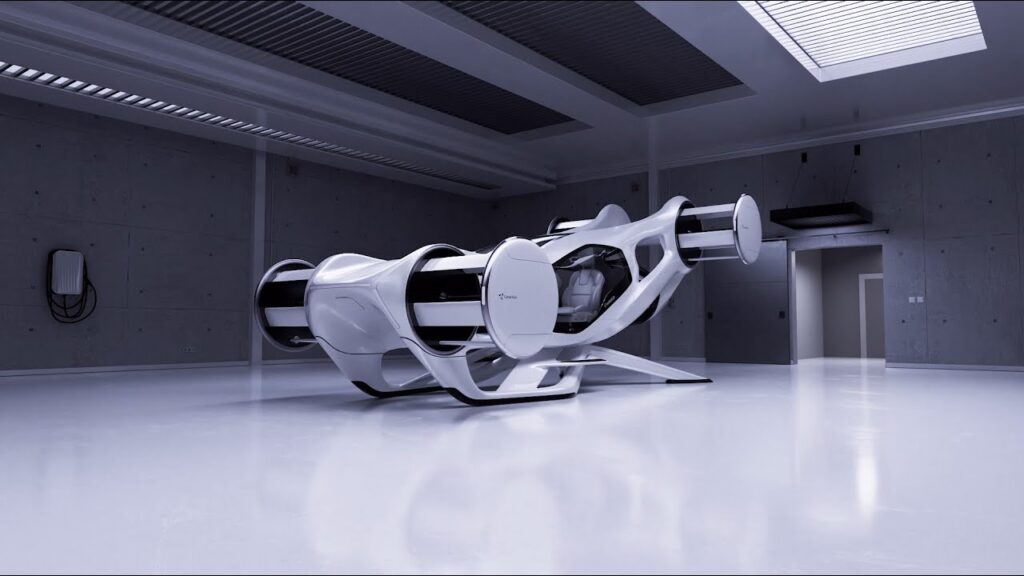Imagine a world where transportation is no longer constrained by roads or traditional flight paths. The ‘Blackbird,’ a cutting-edge flying taxi, embodies this vision with its revolutionary propulsion system that allows it to move seamlessly in any direction. By combining advanced engineering with futuristic design, the Blackbird is set to transform urban mobility, promising speed, flexibility, and sustainability in the increasingly crowded skies of tomorrow.
The Dawn of Urban Air Mobility
The concept of flying taxis has long been a staple of science fiction, from The Fifth Element to Blade Runner. However, rapid advancements in technology are turning this once-distant dream into reality. Urban air mobility (UAM) has become a hotbed of innovation, with companies worldwide racing to develop electric vertical take-off and landing (eVTOL) vehicles that promise to reduce congestion, cut travel times, and offer environmentally friendly alternatives to traditional transportation.
Blackbird stands out in this burgeoning field not only because of its sleek aesthetics but also due to its groundbreaking propulsion system, which sets a new benchmark for maneuverability and efficiency. Unlike traditional helicopters or drones, Blackbird uses omnidirectional thrust technology, allowing it to spin, hover, and glide effortlessly in any direction without the constraints of fixed-wing or rotor designs.
The Game-Changing Propulsion System
At the heart of Blackbird’s innovation is its proprietary propulsion system, which leverages advanced electric ducted fan (EDF) technology combined with artificial intelligence (AI)-driven controls. This system allows for unparalleled agility and precision in flight, enabling the Blackbird to:
Hover in Place: Like a traditional helicopter, but with greater stability and efficiency.
Move Laterally: Slide smoothly to the left, right, or diagonally without the need for turning.
Spin 360 Degrees: Rotate on its axis to reorient instantly, ideal for navigating tight urban spaces.
Seamlessly Transition: Move from vertical to horizontal flight modes for maximum speed and efficiency.
The EDFs are strategically placed to balance thrust and minimize noise pollution, a critical consideration for urban environments. This system eliminates the need for large rotors, making the Blackbird more compact and safer to operate in crowded areas.
Design: A Futuristic Masterpiece
Blackbird’s design is as impressive as its technology. The sleek, carbon-fiber body is both lightweight and durable, optimizing performance while ensuring safety. Its aerodynamic shape reduces drag, enhancing energy efficiency and allowing for longer flight ranges.
The interior is equally forward-thinking. Designed to accommodate four passengers comfortably, the cabin features plush seating, panoramic windows for breathtaking views, and an AI-powered interface that provides real-time information about the journey. The cockpit, though primarily automated, includes manual controls for a pilot, ensuring versatility in operation.
How Blackbird Works
The Blackbird’s operations are entirely electric, powered by high-density lithium-silicon batteries. These batteries offer longer ranges and faster charging times compared to traditional lithium-ion technology. With a single charge, the Blackbird can travel up to 200 miles at speeds of 200 mph, making it a practical solution for medium-distance commutes.
The propulsion system is managed by an advanced AI system that continuously monitors flight conditions, adjusting thrust in real-time to maintain stability and efficiency. This autonomous technology not only enhances safety but also reduces the cognitive load on pilots, paving the way for fully autonomous flying taxis in the future.
Key Features of Blackbird
Omnidirectional Movement: Revolutionary thrust technology allows the Blackbird to move seamlessly in any direction.
Zero-Emission Operation: Fully electric propulsion ensures eco-friendly operation.
Compact Design: No large rotors make the vehicle safe and practical for urban environments.
Advanced Safety Features: AI-driven monitoring, redundant systems, and obstacle-avoidance sensors ensure passenger safety.
Quiet Operation: Noise-reduction technology minimizes disturbance in residential areas.
Comfortable Cabin: Luxury seating and smart interfaces enhance passenger experience.
The Blackbird is not just a technological marvel but also a potential game-changer for various industries. Its versatility opens the door to a wide range of applications, including:
Urban Transportation: Reducing travel times in congested cities by bypassing ground traffic.
Emergency Services: Rapid deployment for medical evacuations, disaster response, and firefighting.
Tourism: Offering unique aerial experiences and scenic tours.
Corporate Travel: Providing fast, efficient transport for executives and business travelers.
By addressing the challenges of urban mobility, Blackbird has the potential to revolutionize how people and goods move through cities. Its zero-emission operation aligns with global efforts to combat climate change, making it a sustainable alternative to traditional modes of transport.
Challenges and Opportunities
While the promise of flying taxis is exciting, the industry faces several challenges, including:
•Regulation: Airspace management and safety regulations need to evolve to accommodate UAM vehicles.
•Infrastructure: Urban areas must invest in vertiports and charging stations to support eVTOL operations.
•Cost: The initial expense of developing and deploying flying taxis may limit accessibility.
However, Blackbird’s innovative design and technology position it well to overcome these hurdles. Its compact size and quiet operation reduce the need for extensive infrastructure, while advancements in battery technology and mass production are expected to lower costs over time.
The Competitive Landscape
Blackbird enters a crowded market of eVTOL developers, including established players like Joby Aviation, Lilium, and Volocopter. However, its unique propulsion system gives it a competitive edge, offering capabilities that other models lack. While many competitors focus on linear flight and hover capabilities, Blackbird’s omnidirectional movement sets it apart as a versatile and agile option.
Looking to the Future
The launch of Blackbird marks a significant milestone in the journey toward widespread adoption of flying taxis. As the industry evolves, advancements in battery technology, AI, and air traffic management will further enhance the feasibility of UAM. Blackbird’s pioneering propulsion system serves as a blueprint for the next generation of eVTOL vehicles, showcasing what’s possible when innovation meets ambition.
Public Reaction and Industry Buzz
Since its unveiling, Blackbird has garnered significant attention from industry experts, investors, and the general public. Many have praised its sleek design and groundbreaking technology, while others have raised questions about its practical implementation in real-world scenarios.
Early test flights have demonstrated the vehicle’s capabilities, generating excitement among potential customers and partners. Urban planners and governments are closely watching Blackbird’s development, recognizing its potential to address pressing transportation challenges.
Impression
The Blackbird flying taxi is more than just a technological innovation—it’s a glimpse into the future of urban mobility. With its revolutionary propulsion system, eco-friendly operation, and versatile design, Blackbird has the potential to redefine how people navigate cities, offering a faster, greener, and more connected alternative to traditional transport.
As the world grapples with the challenges of urbanization and climate change, vehicles like Blackbird represent a bold step forward. By embracing cutting-edge technology and reimagining the possibilities of flight, Blackbird is paving the way for a new era of transportation—one that’s not just about getting from point A to point B, but doing so in a way that’s efficient, sustainable, and inspiring.
No comments yet.








